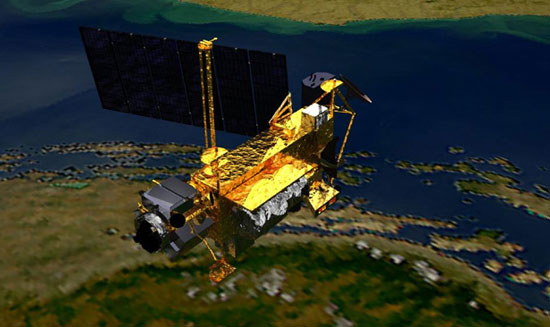Identify the fall position of the US satellite
The US Aeronautics Agency (NASA) announces that their 6-tonne mass satellite has fallen to the northeast of the Vanuatu archipelago.
The BBC quoted NASA as saying that its experts identified the Research Satellite of the Upper Layer (UARS) into the atmosphere above the Pacific at 14.1 latitude and 170.2 longitude. west at about 4:00 pm on September 24 at GMT (11:00 am on the same day in Vietnam). They claim that the unburnt fragments of the satellite have fallen to the northeast of the Vanuatu Islands in the Pacific Ocean.
NASA's computer model shows that the total mass of unburnt fragments is about 500kg. They fall into an area about 800km long. If the result of the model is correct, every debris falls into the ocean.

The fall of UARS attracted the attention of world opinion.
UARS is America's largest artificial satellite falling uncontrollably over the past 30 years. Its fall attracted international attention last week, because many scientists predicted it could turn into a fireball when rubbed with air.
According to experts, UARS's falling speed increased very quickly when it began to reach the top floor of the atmosphere - about 100km from the ground. Initially uncertain parts - such as antennas or solar panels - will be thrown out of the satellite body by the impact of external forces. Then the satellite caught fire as it plunged deeper into the atmosphere due to rubbing against the air. At that time, the satellite began to deform and parts made of poor heat-resistant metal began to melt.
Parts made of good heat-resistant metals - such as stainless iron, titanium, beryllium - do not melt and fall to the ground. Of the more than 100 UARS fragments, about 26 fragments will fall to the ground with a mass of between 1 and 150kg.
Predicting the time and place of the fall of cosmic trash is difficult because many factors affect their fall - such as the expansion of the atmosphere, the shape of the garbage, the direction of falling, atmospheric pressure. , the wind. NASA once claimed they could pinpoint UARS's fall site about two hours before it entered the atmosphere, but they had not done it.
- Satellite weighs 1 ton preparing to fall to Earth
- Russian satellites are about to fall to Earth
- How does satellite track the plane?
- The fall of satellites made the Earth
- Accurate fall point of German satellites
- The Swarm satellite trio has entered the position
- Can the German satellite fall to Vietnam?
- There are satellites weighing nearly 6 tons about to fall to Earth
- America's oldest 'satellite' falls to Earth
- Fragments of Chinese satellite fall to the field
- GOCE satellite is about to fall to earth
- Japan launched a satellite that could identify 1m objects, take night photos
 Van Allen's belt and evidence that the Apollo 11 mission to the Moon was myth
Van Allen's belt and evidence that the Apollo 11 mission to the Moon was myth The levels of civilization in the universe (Kardashev scale)
The levels of civilization in the universe (Kardashev scale) Today Mars, the sun and the Earth are aligned
Today Mars, the sun and the Earth are aligned The Amazon owner announced a secret plan to build a space base for thousands of people
The Amazon owner announced a secret plan to build a space base for thousands of people